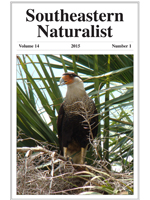Using Elephas maximus (Asian Elephant) and Equus ferus caballus (Domesticated Horse) as ecological analogs to extinct Pleistocene mammals, we tested the effect of gut passage on 3 proposed anachronistic fruits: Diospyros virginiana (American Persimmon), Maclura pomifera (Osage Orange), and Asimina triloba (Paw Paw). We found that elephant-gut passage of persimmon seeds increased their germination success and decreased their time to sprout, while Osage Orange seeds showed no benefit to gut passage. Neither American Persimmon nor Osage Orange seeds survived gut passage through horses. Both mammals refused to consume Paw Paw fruits. Assuming a similar physiology and behavior compared to our modern analogs, we suggest that extinct North American elephant species could have been important seed dispersers for American Persimmons but were unlikely to be effective for Osage Orange or Paw Paw, while horses would have been poor dispersers for all plant species tested.
How to translate text using browser tools
1 March 2015
A Test of Potential Pleistocene Mammal Seed Dispersal in Anachronistic Fruits using Extant Ecological and Physiological Analogs
Madison J. Boone,
Charli N. Davis,
Laura Klasek,
Jillian F. del Sol,
Katherine Roehm,
Matthew D. Moran
ACCESS THE FULL ARTICLE

Southeastern Naturalist
Vol. 14 • No. 1
March 2015
Vol. 14 • No. 1
March 2015




